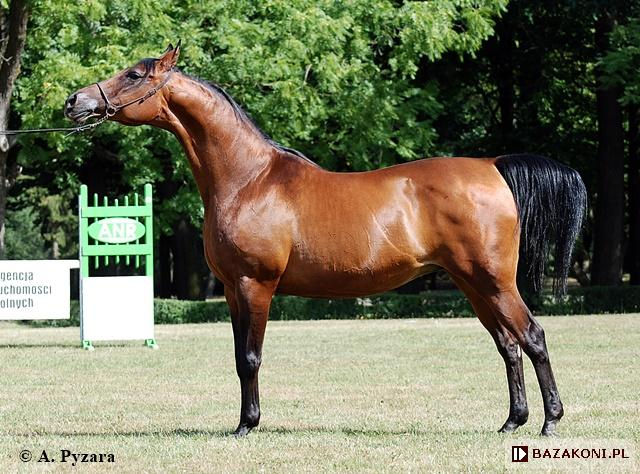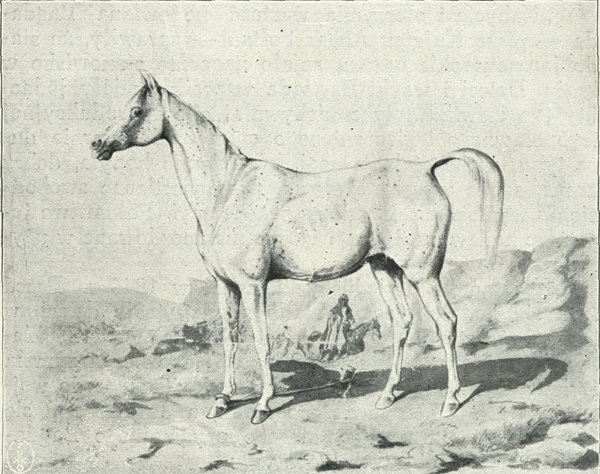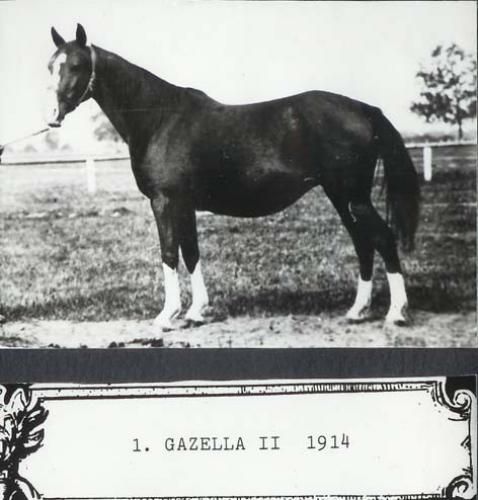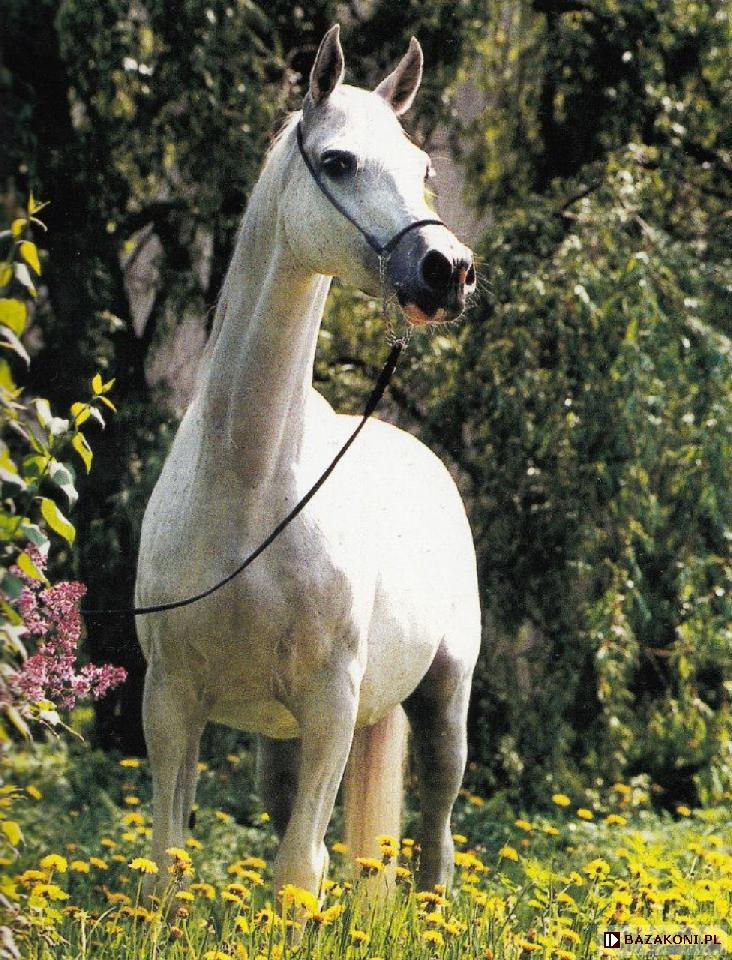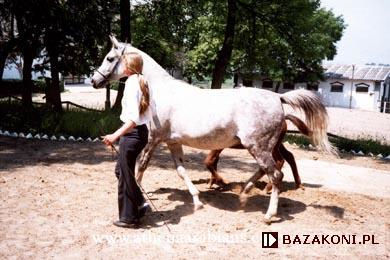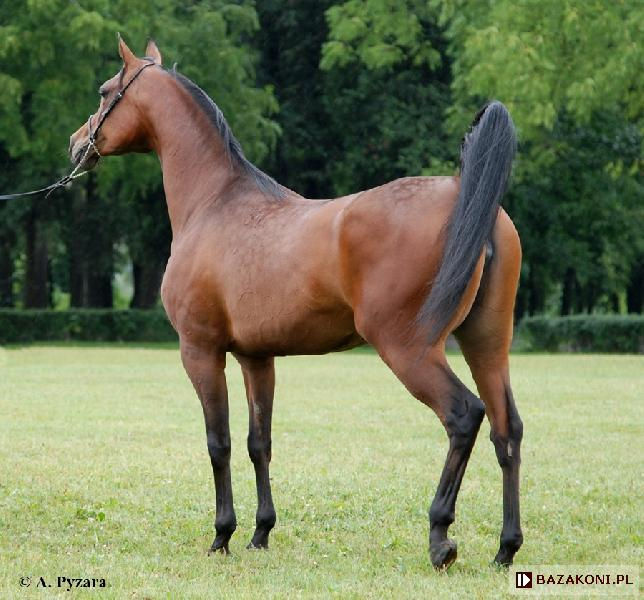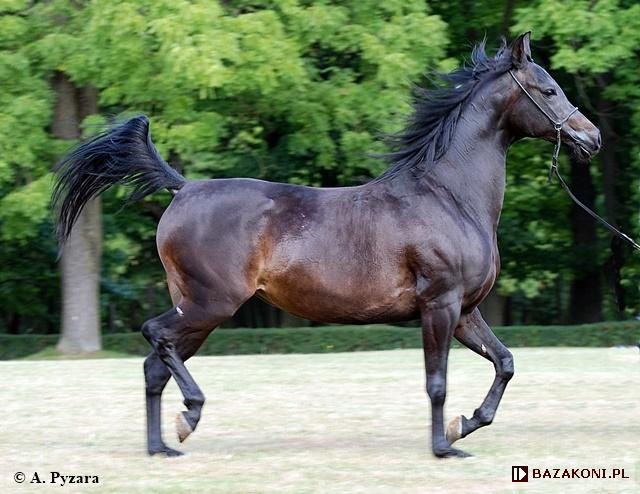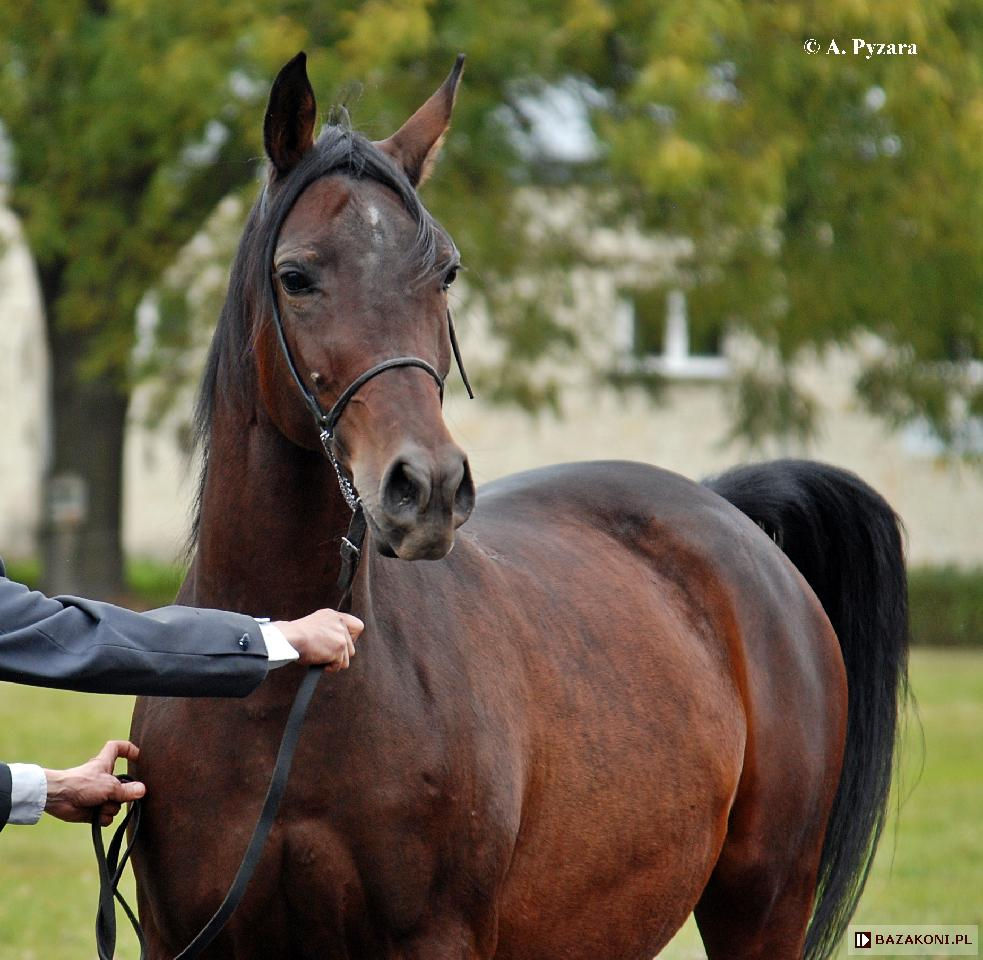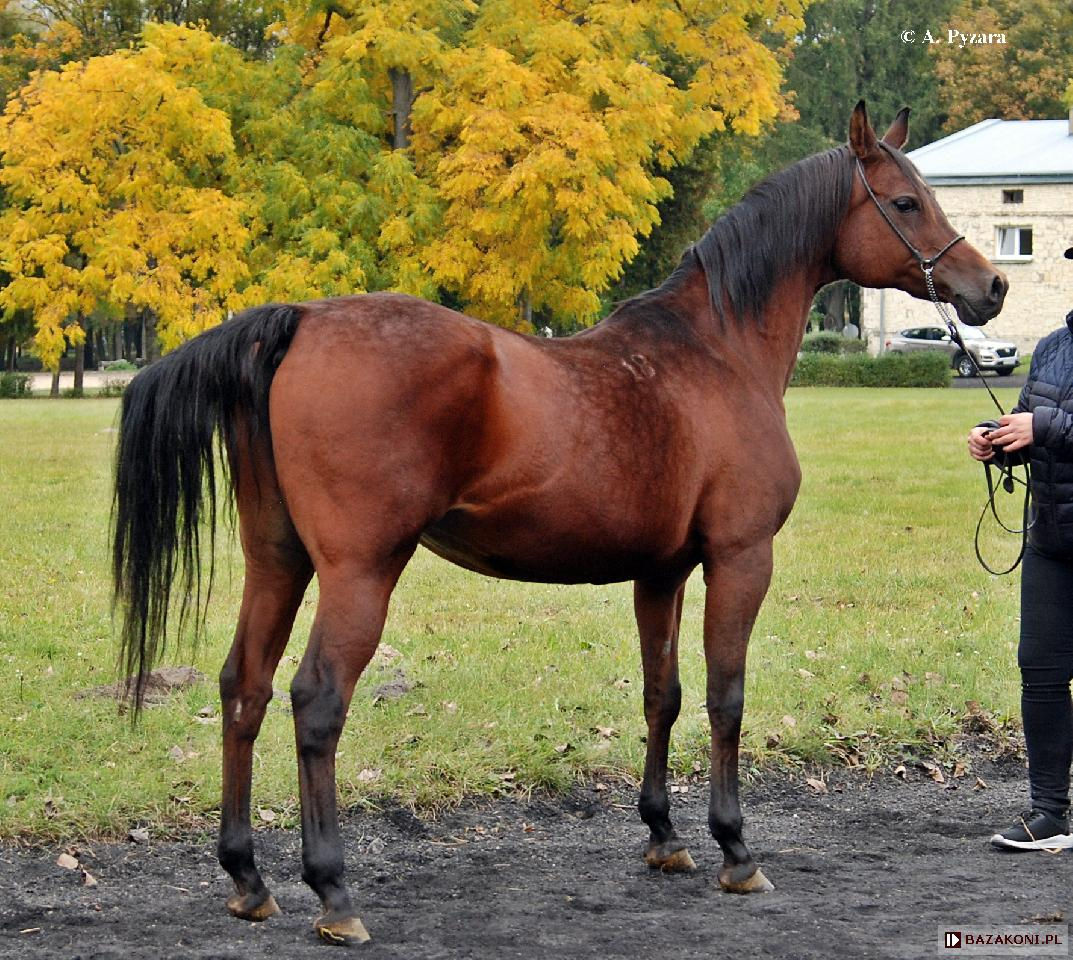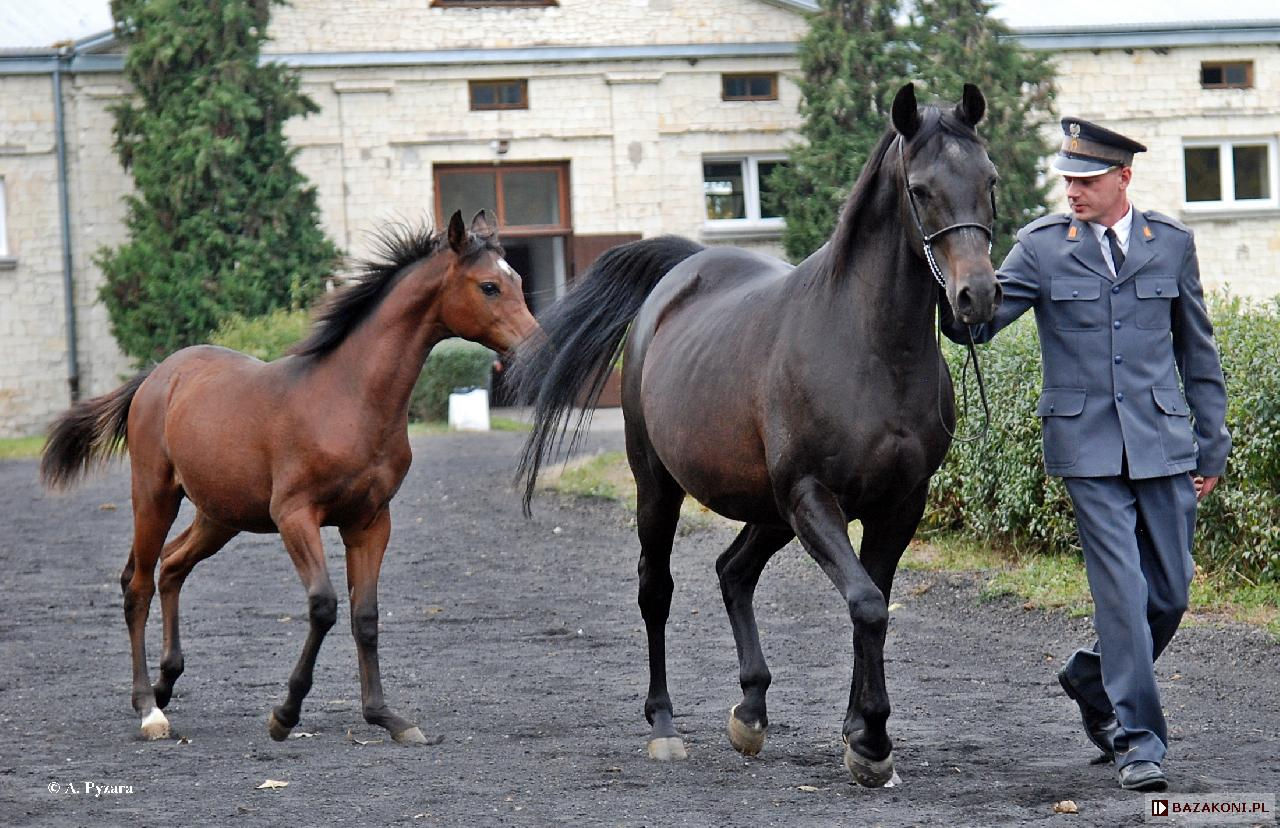ARTICLES
Mare line Gazella d.b. at the Białka Horse Stud
Author: Hanna Sztuka
Cirka 1994 Borek-Cuma po Eukaliptus hod.SK Kurozwęki
CIRKA bay
1.04.1994 by Borek out of Cuma by Eukaliptus
Sire line: Kuhailan Afas d.b. imp.1931 to
Gumniska
Dam line: Gazella d.b. imp. 1845 to Jarczowce
Mare family:
Cyrkulacja 1974 bred by Kurozwęki Stud
PASB Volume 13-3 page 14, bred by
Kurozwęki Stud, purchased on October 8th, 1998 to Białka Stud
On April 1st, 1994, at Kurozwęki Stud, a daughter of the stallion Borek
was born – the filly Cirka out of Cuma by Eukaliptus, - a representative of the Gazella d.b. dam
line, imported in 1845 to Jarczowce by Count Juliusz Dzieduszycki. The story of her origin tells the
path of Polish breeding, full of dramatic events, from the mid-19th century to the present
day.
Cirka was raised in Kurozwęki, but it was already the decline
period of the activity of this third (established in 1973) state stud for Arabian horses. The State
Stud Farm in Kurozwęki ended its breeding activities in 1998 and the entire herd of mares was sold.
The most valuable mares were, by decision of the ANR (Agricultural Property Agency), transferred to
other state studs: Janów, Michałów and Białka, and the remaining mares were purchased by the private
stud Tarus Arabians. A few mares remained in the reprivatized Kurozwęki. Attempts were made to
protect this breeding, at least to a minimal extent, as it was at that time that it began to achieve
its first significant successes. However, the economic realities of the late 1990s and the
privatization policy of the then ANR did not find arguments for preserving this breeding as a whole.
The mares that went to the studs in Janów and Michałów were selected to protect the dam lines
located in Kurozwęki, but were lost in these studs. Białka Stud, in turn, received almost all of the
best breeding material from Kurozwęki, i.e. young mares, among which there were several extremely
valuable daughters of show-type stallions Palas, Eukaliptus and Ararat, which were beginning to
dominate in Polish breeding. Cirka, whose very beautiful dam, Cuma 1990 by Eukaliptus, was sold to
private breeding - was among the group of mares transferred to Białka. She came to Białka in foal to
the Janów-bred son of Eukaliptus, the stallion Harbin, who became the sire of her first offspring,
the stallion Circus, born in Białka in 1999. Cirka gave birth to 12 foals in Białka, including four
mares incorporated into breeding: Citroneta 2000 by Pesal, Cirilla 2006 by Ekstern, Cirlita 2011 by
Eryks and Cilia 2018 by Medalion.
Gazella or.ar. 1840 hod.Anazeh Sebaa, imp.1845 Jarczowce, Akwarela Juliusz Kossak około
1850r.
Cirka represents the dam line of the
mare Gazella d.b. imported to Jarczowce in 1845 by Count Juliusz Dzieduszycki, who died without
issue in 1885. After his death, the stud was inherited by his nephew, Count Wojciech Dzieduszycki,
who had no passion for Arabian horses: he selected 12 mares from Jarczowce and moved them to
Jezupol. The rest of Juliusz Dzieduszycki's horses were sold to other studs. Only when the Jezupol
stud was taken over by his son Władysław in 1894, the Jarczowce traditions were revived.
Unfortunately, already in 1914, almost all the horses from the stud in Jezupol were taken by German
troops. Left in Jezupol was one mare, Pomponia 1902, and three several-month-old fillies Jezupol:
Gazella II 1914, Mlecha 1914 and Zulejma 1914. Władysław Dzieduszycki was forced to sell the fillies
that survived the conflagration of the revolution and World War I, thus ending his family's many
years of breeding. Ultimately, the Jezupol fillies were transferred to the newly established Arabian
horse department at Janów Podlaski State Stud, where each of them created their own, extremely
valuable line.
Gazella II 1914 Koheilan or.ar.-Abra po Anvil hod. W.Dzieduszycki
Jezupol
Gazella II 1914, was one of the most important broodmares of Janów
Podlaski in the interwar period. She turned out to be an extremely valuable dam, whom the then
breeder at Janów Podlaski State Stud, Stanisław Pohoski, had particular trust in. In the following
years the following daughters of Gazella II were born: Elegantka 1923, Fryga II 1924, Jaskółka II
1928, Makata 1931, Najada 1932 and Taraszcza 1937. Her line was rebuilt also after World War II,
although Gazella II 1914 and other valuable mares from this line were stolen by the Russians in 1939
and ended up in Tersk in the Caucasus. The offspring of Gazella II became an invaluable source of
blood for many generations for breeders both in Poland and the USSR.
Cyrkulacja 1974 Palas-Cykuta po Mir Said hod.SK Kurozwęki
One of
Gazella II's granddaughters, Rozeta 1935 by Almanzor, was sold before the war from Janów to a
private breeding in the Śmiłowice estate and was fortunately among the group of horses that survived
World War II in southern Poland. Through the Raba Wyżna Stud, the already "nationalized" Rozeta came
to Nowy Dwór Stud. Born in Nowy Dwór, her daughter Cerozja 1949 by Wielki Szlem, was transferred to
Albigowa Stud, and then she and her daughter Cyneraria 1961 by Sędziwój, after the liquidation of
the stud farm in Albigowa, went to Janów Podlaski. Cerozja founded her own family in Janów, active
to this day and currently represented by the mares Cereza 2008 and Cedora
2013.
Ciupaga 1984
Banat-Cyrkulacja po Palas hod.SK Kurozwęki
When
in 1973, the next stud farm after Janów and Michałów was established in Kurozwęki, Cyneraria's
daughter, Cykuta 1966 by Mir Said, in foal to the stallion Palas, was transferred there from Janów.
The grey Cyrkulacja 1974 by Palas out of Cykuta by Mir Said, born in Kurozwęki, began her own family
in Kurozwęki, which was then continued in Białka, where, after the privatization of Kurozwęki, her
daughter Ciupaga 1984 by Banat and granddaughter Cirka 1994 by Borek came. Currently, the family of
Cyrkulacja 1974 is represented at Białka Stud by four broodmares: Cirilla 2006 by Ekstern, Cirlita
2011 by Eryks, Cilia 2018 by Medalion, Chilia 2020 by Alert and seven young fillies. In parallel
with the family of Cyrkulacjaa 1974 from Kurozwęki, there is a family in Białka founded by the mare
Carmen 1985, also descended from Janów's Elegantka 1923, which, despite previous successes in
breeding, including the top stallion Celsjusz 2004 by Ekstern, is currently represented by one young
filly, Cuba 2023 by Palatino, whose future breeding career will decide whether the Carmen 1985
family in Białka will develop or on the contrary.
Cirilla 2006
Ekstern-Cirka po Borek hod.SO Białka
The dam
line of Gazella d.b., prolonged by the mare Gazella II 1914, is represented in Polish state breeding
by mares that can be found in the pedigrees of numerous valuable mares and stallions, where there
are both exceptionally beautiful and exceptionally brave horses. One of the most interesting
examples is the progeny of the mare Fryga II 1924, which, through Ofirka 1939, miraculously saved
from Soviet plunder, produced mares without whom it is difficult to imagine Polish breeding today.
Mares descended directly from Ofirka are known for their outstanding performance and currently,
although only a few, continue breeding in dam families in Janów: Oktavia 2003 by Om El Extreem and
in Białka: Orea 2012 by Eryks and Orletta 2017 by El Omari. In turn, Ofirka's daughter Gastronomia
1946, who came to Michałów, produced a number of beautiful mares, and from the family she founded
come such mares as World Champion Galilea 2000 by Laheeb, the titled Galerida 2013 by Shanghai E.A.,
and one of the most beautiful current mares in Michałów - Goltemma 2018 by Sahm El
Arab.
Cirlita 2011
Eryks-Cirka po Borek hod. SO Białka
The complicated fates of Arabian horses
at the turn of the 19th and 20th centuries, which survived the revolution, two world wars,
nationalization and changing of breeding concepts, show how excellent the consistent work of Polish
breeders to preserve the heritage of the former borderland stud farms was. This extraordinary
persistence over time and the passion for Arabian horses passed down from generation to generation
means that Poles can still boast the oldest dam families in world breeding. Currently, in this
heritage of generations, the divisions between state and private breeding are blurred, although the
former, due to the protection of the state, has a greater chance of breeding to preserve native sire
and dam lines.
Cilia 2018 Medalion-Cirka po
Borek
Cirilla 2006 Ekstern-cirka
po Borek (photo taken in year 2023)
Klacz Cirlita ze źrebięciem (photo taken in year 2023)




